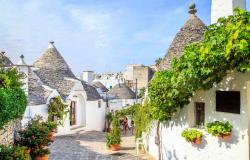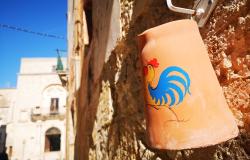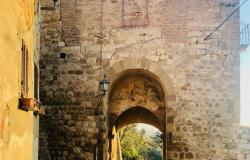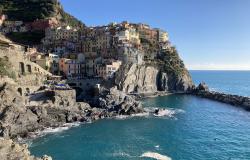Unesco Sites of Italy: The Rhaetian Railway in the Albula / Bernina Landscapes
ITA:

Use player to listen to Italian version
The Rhaetian Railway in the Albula / Bernina Landscapes, which in Italy we know as the ‘trenino rosso del Bernina,’ is a mountain railway line, the highest in Europe, which connects the Italian town of Tirano to the Swiss town of St. Moritz, crossing the Alps. It is therefore a site shared between Italy and Switzerland.
The highest point it reaches is Ospizio del Bernina (2253m), and in its journey, thanks to large panoramic windows, it affords 360° breathtaking views of the Alpine landscape around.
As explained on the Unesco website, the Rhaetian Railway brings together two historic railway lines: the Albula line, opened in 1904, is 67 km long, and features 42 tunnels and covered galleries and 144 viaducts and bridges; the 61-km-long Bernina pass line features 13 tunnels and galleries and 52 viaducts and bridges.
“The property is exemplary of the use of the railway to overcome the isolation of settlements in the Central Alps early in the 20th century,” explains Unesco. “It constitutes an outstanding technical, architectural and environmental ensemble and embodies architectural and civil engineering achievements, in harmony with the landscapes through which they pass.”
The Bernina Express is also a journey through different linguistic and cultural areas. While the trip between Tirano and St. Moritz takes about two and a half hours, you may opt to get off at the various little towns in between, such as Poschiavo, Cavaglia, Miralago, Alp Grum, Ospizio Bernina and Pontresina (this option would require more days).
Or, if you want to do it in a day, you may catch the bus from Milan to St. Moritz, and, after driving through the legendary Maloja Pass with its 14 hairpin bends, reach St. Moritz and have some time to visit the wealthy Swiss town, then hop on the Bernina Express and return to Milan in the evening, catching the bus from Tirano.
More information is available on the Bernina Express official website.
La ferrovia retica nel paesaggio dell'Albula e del Bernina, che in Italia conosciamo come il ‘trenino rosso del Bernina’, è una linea ferroviaria di montagna, la più alta d'Europa, che collega la città italiana di Tirano alla città svizzera di St. Moritz, attraversando le Alpi. È quindi un sito Unesco condiviso tra Italia e Svizzera.
Il punto più alto che raggiunge è l'Ospizio del Bernina, a 2253 metri d’altitudine, e, nel suo viaggio, grazie alle grandi finestre panoramiche, offre una vista mozzafiato a 360° sul paesaggio alpino circostante.
Come spiegato sul sito web dell'Unesco, la Ferrovia retica è l’unione di due linee ferroviarie storiche: la linea Albula, aperta nel 1904, è lunga 67 km e comprende 42 tunnel e gallerie coperte e 144 viadotti e ponti; la linea del passo del Bernina è lunga 61 km e comprende 13 tunnel e gallerie e 52 viadotti e ponti.
“Il sito è esemplare nell'uso della ferrovia per superare l'isolamento delle comunità delle Alpi centrali all'inizio del XX° secolo”, spiega l'Unesco. “Costituisce un unicum eccezionale di tecnologia, architettura, ingegneria e rispetto per l'ambiente, in armonia con i paesaggi che attraversa”.
Il Bernina Express è anche un viaggio attraverso diverse aree linguistiche e culturali. Il percorso tra Tirano e St. Moritz dura circa due ore e mezza, ma si può decidere di scendere a visitare alcune delle piccole città che si attraversano lungo il percorso, tra cui Poschiavo, Cavaglia, Miralago, Alp Grum, Ospizio Bernina e Pontresina (questa opzione richiede più giorni).
Oppure, volendo fare la gita in giornata, si può prendere un pullman da Milano a St. Moritz, e, dopo aver attraversato il leggendario Passo del Maloja con i suoi 14 tornanti, raggiungere e visitare la ricca cittadina svizzera, quindi salire sul Bernina Express e rientrare a Milano la sera, riprendendo il pullman da Tirano.
Maggiori informazioni sono disponibili sul sito ufficiale del Bernina Express.











